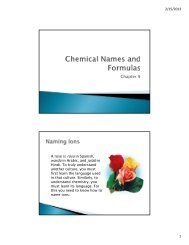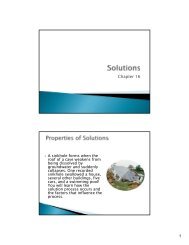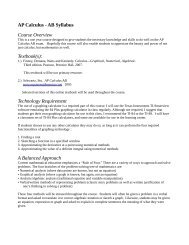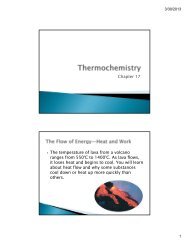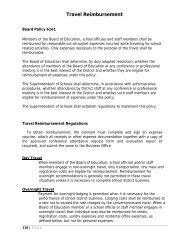Chapter 13 States of Matter
Chapter 13 States of Matter
Chapter 13 States of Matter
Create successful ePaper yourself
Turn your PDF publications into a flip-book with our unique Google optimized e-Paper software.
2/15/20<strong>13</strong><br />
<strong>Chapter</strong> <strong>13</strong><br />
The skunk releases its spray!<br />
Within seconds you smell<br />
that all-too-familiar foul<br />
odor. You will discover some<br />
general characteristics <strong>of</strong><br />
gases that help explain how<br />
odors travel through the air,<br />
even on a windless day.<br />
1
2/15/20<strong>13</strong><br />
Kinetic Theory and a Model for Gases<br />
◦ What are the three assumptions <strong>of</strong> the kinetic<br />
theory as it applies to gases?<br />
• The word kinetic refers to motion.<br />
• The energy an object has because <strong>of</strong> its motion is called<br />
kinetic energy.<br />
• According to the kinetic theory, all matter consists <strong>of</strong> tiny<br />
particles that are in constant motion.<br />
2
2/15/20<strong>13</strong><br />
• According to kinetic theory:<br />
a. The particles in a gas are considered<br />
to be small, hard spheres with an<br />
insignificant volume.<br />
b. The motion <strong>of</strong> the particles in a gas<br />
is rapid, constant, and random.<br />
c. All collisions between particles in a<br />
gas are perfectly elastic.<br />
• Particles in a gas are in rapid, constant motion.<br />
3
2/15/20<strong>13</strong><br />
• Gas particles travel in straight-line paths.<br />
• The gas fills the container.<br />
4
2/15/20<strong>13</strong><br />
Gas Pressure<br />
◦ How does kinetic theory explain gas pressure?<br />
• Gas pressure results from the force exerted by a gas<br />
per unit surface area <strong>of</strong> an object.<br />
• An empty space with no particles and no pressure is called<br />
a vacuum.<br />
• Atmospheric pressure results from the collisions <strong>of</strong> atoms<br />
and molecules in air with objects.<br />
◦ Gas pressure is the result <strong>of</strong> simultaneous collisions<br />
<strong>of</strong> billions <strong>of</strong> rapidly moving particles in a gas with<br />
an object.<br />
• A barometer is a device that is used to measure<br />
atmospheric pressure.<br />
5
2/15/20<strong>13</strong><br />
• The SI unit <strong>of</strong> pressure is the pascal (Pa).<br />
• One standard atmosphere (atm) is the pressure required<br />
to support 760 mm <strong>of</strong> mercury in a mercury barometer at<br />
25°C.<br />
• Reference table A<br />
Kinetic Energy and Temperature<br />
◦ What is the relationship between the temperature in<br />
kelvins and the average kinetic energy <strong>of</strong> particles?<br />
Average Kinetic Energy<br />
◦ The particles in any collection <strong>of</strong> atoms or<br />
molecules at a given temperature have a wide range<br />
<strong>of</strong> kinetic energies. Most <strong>of</strong> the particles have<br />
kinetic energies somewhere in the middle <strong>of</strong> this<br />
range.<br />
6
2/15/20<strong>13</strong><br />
• Absolute zero (0 K, or –273.15°C) is the temperature<br />
at which the motion <strong>of</strong> particles theoretically ceases.<br />
• Particles would have no kinetic energy at absolute zero.<br />
• Absolute zero has never been produced in the<br />
laboratory.<br />
• Reference table A<br />
7
2/15/20<strong>13</strong><br />
◦ Average Kinetic Energy and Kelvin Temperature<br />
• The Kelvin temperature <strong>of</strong> a substance is directly<br />
proportional to the average kinetic energy <strong>of</strong> the<br />
particles <strong>of</strong> the substance.<br />
• In this vacuum chamber, scientists cooled sodium<br />
vapor to nearly absolute zero.<br />
8
2/15/20<strong>13</strong><br />
Hot lava oozes and flows,<br />
scorching everything in its<br />
path, and occasionally<br />
overrunning nearby houses.<br />
When the lava cools, it<br />
solidifies into rock. The<br />
properties <strong>of</strong> liquids are<br />
related to intermolecular<br />
interactions. You will learn<br />
about some <strong>of</strong> the properties<br />
<strong>of</strong> liquids.<br />
A Model for Liquids<br />
◦ What factors determine the physical properties <strong>of</strong> a<br />
liquid?<br />
9
2/15/20<strong>13</strong><br />
• Substances that can flow are referred to as fluids. Both<br />
liquids and gases are fluids.<br />
◦ The interplay between the disruptive motions <strong>of</strong><br />
particles in a liquid and the attractions among the<br />
particles determines the physical properties <strong>of</strong><br />
liquids.<br />
10
2/15/20<strong>13</strong><br />
Evaporation<br />
◦ What is the relationship between evaporation and<br />
kinetic energy?<br />
• The conversion <strong>of</strong> a liquid to a gas or vapor is called<br />
vaporization.<br />
• When such a conversion occurs at the surface <strong>of</strong> a liquid<br />
that is not boiling, the process is called evaporation.<br />
• In an open container, molecules that evaporate can<br />
escape from the container.<br />
11
2/15/20<strong>13</strong><br />
• In a closed container, the molecules cannot escape.<br />
They collect as a vapor above the liquid. Some<br />
molecules condense back into a liquid.<br />
◦ During evaporation, only those molecules with a<br />
certain minimum kinetic energy can escape from<br />
the surface <strong>of</strong> the liquid.<br />
12
2/15/20<strong>13</strong><br />
Vapor Pressure<br />
◦ When can a dynamic equilibrium exist between a<br />
liquid and its vapor?<br />
• Vapor pressure is a measure <strong>of</strong> the force exerted by a<br />
gas above a liquid.<br />
<strong>13</strong>
2/15/20<strong>13</strong><br />
◦ In a system at constant vapor pressure, a dynamic<br />
equilibrium exists between the vapor and the liquid.<br />
The system is in equilibrium because the rate <strong>of</strong><br />
evaporation <strong>of</strong> liquid equals the rate <strong>of</strong><br />
condensation <strong>of</strong> vapor.<br />
◦ Vapor Pressure and Temperature Change<br />
• An increase in the temperature <strong>of</strong> a contained liquid<br />
increases the vapor pressure.<br />
• The particles in the warmed liquid have increased kinetic<br />
energy. As a result, more <strong>of</strong> the particles will have the<br />
minimum kinetic energy necessary to escape the surface<br />
<strong>of</strong> the liquid.<br />
14
2/15/20<strong>13</strong><br />
◦ Vapor Pressure Measurements<br />
• The vapor pressure <strong>of</strong> a liquid can be determined with<br />
a device called a manometer.<br />
15
2/15/20<strong>13</strong><br />
Boiling Point<br />
◦ Under what conditions does boiling occur?<br />
◦ When a liquid is heated to a temperature at<br />
which particles throughout the liquid have<br />
enough kinetic energy to vaporize, the liquid<br />
begins to boil.<br />
◦ The temperature at which the vapor pressure<br />
<strong>of</strong> the liquid is just equal to the external<br />
pressure on the liquid is the boiling point (bp).<br />
◦ Boiling Point and Pressure Changes<br />
• Because a liquid boils when its vapor pressure is<br />
equal to the external pressure, liquids don’t always<br />
boil at the same temperature.<br />
• At a lower external pressure, the boiling point<br />
decreases.<br />
• At a higher external pressure, the boiling point<br />
increases.<br />
16
2/15/20<strong>13</strong><br />
• Altitude and Boiling Point<br />
Ref. table H<br />
17
2/15/20<strong>13</strong><br />
◦ Normal Boiling Point<br />
• Because a liquid can have various boiling points<br />
depending on pressure, the normal boiling point is<br />
defined as the boiling point <strong>of</strong> a liquid at a pressure <strong>of</strong><br />
101.3 kPa.<br />
18
2/15/20<strong>13</strong><br />
In 1985, scientists<br />
discovered a new form <strong>of</strong><br />
carbon. They called this<br />
form <strong>of</strong> carbon<br />
buckminsterfullerene, or<br />
buckyball for short. You will<br />
learn how the arrangement<br />
<strong>of</strong> particles in solids<br />
determines some general<br />
properties <strong>of</strong> solids.<br />
A Model for Solids<br />
◦ How are the structure and properties <strong>of</strong> solids<br />
related?<br />
◦ The general properties <strong>of</strong> solids reflect the orderly<br />
arrangement <strong>of</strong> their particles and the fixed<br />
locations <strong>of</strong> their particles.<br />
◦ The melting point (mp) is the temperature at which<br />
a solid changes into a liquid.<br />
19
2/15/20<strong>13</strong><br />
Crystal Structure and Unit Cells<br />
◦ What determines the shape <strong>of</strong> a crystal?<br />
◦ In a crystal, the particles are arranged in an orderly,<br />
repeating, three-dimensional pattern called a<br />
crystal lattice.<br />
The shape <strong>of</strong> a crystal<br />
reflects the arrangement<br />
<strong>of</strong> the particles within the<br />
solid.<br />
◦ Crystal Systems<br />
• A crystal has sides, or faces. Crystals are classified into<br />
seven crystal systems.<br />
20
2/15/20<strong>13</strong><br />
• These minerals show four out <strong>of</strong> the seven crystal<br />
systems.<br />
• The smallest group <strong>of</strong> particles within a crystal that<br />
retains the geometric shape <strong>of</strong> the crystal is known as a<br />
unit cell.<br />
• A crystal lattice is a repeating array <strong>of</strong> any one <strong>of</strong> fourteen<br />
kinds <strong>of</strong> unit cells.<br />
• There are from one to four types <strong>of</strong> unit cells that can be<br />
associated with each crystal system.<br />
21
2/15/20<strong>13</strong><br />
• Three kinds <strong>of</strong> unit cells can make up a cubic crystal<br />
system.<br />
◦ Allotropes<br />
• Allotropes are two or more different molecular forms<br />
<strong>of</strong> the same element in the same physical state.<br />
• Allotropes have different properties because their<br />
structures are different.<br />
• Only a few elements have allotropes.<br />
22
2/15/20<strong>13</strong><br />
• Carbon Allotropes<br />
◦ Non-Crystalline Solids<br />
• An amorphous solid lacks an ordered internal<br />
structure.<br />
• Rubber, plastic, asphalt, and glass are amorphous solids.<br />
• A glass is a transparent fusion product <strong>of</strong> inorganic<br />
substances that have cooled to a rigid state without<br />
crystallizing.<br />
23
2/15/20<strong>13</strong><br />
Familiar weather events can<br />
remind you that water exists on<br />
Earth as a liquid, a solid, and a<br />
vapor. As water cycles through<br />
the atmosphere, the oceans,<br />
and Earth’s crust, it undergoes<br />
repeated changes <strong>of</strong> state. You<br />
will learn what conditions can<br />
control the state <strong>of</strong> a<br />
substance.<br />
Sublimation<br />
◦ When can sublimation occur?<br />
◦ The change <strong>of</strong> a substance from a solid to a vapor<br />
without passing through the liquid state is called<br />
sublimation.<br />
◦ Sublimation occurs in solids with vapor pressures<br />
that exceed atmospheric pressure at or near room<br />
temperature.<br />
24
2/15/20<strong>13</strong><br />
• When solid iodine is heated,<br />
the crystals sublime, going<br />
directly from the solid to<br />
the gaseous state. When the<br />
vapor cools, it goes directly<br />
from the gaseous to the<br />
solid state. This is called<br />
deposition.<br />
Phase Diagrams<br />
◦ How are the conditions at which phases are in<br />
equilibrium represented on a phase diagram?<br />
◦ A phase diagram is a graph that gives the<br />
conditions <strong>of</strong> temperature and pressure at which a<br />
substance exists as solid, liquid, and gas (vapor).<br />
◦ The conditions <strong>of</strong> pressure and temperature at<br />
which two phases exist in equilibrium are indicated<br />
on a phase diagram by a line separating the phases.<br />
25
2/15/20<strong>13</strong><br />
• The triple point describes the only set <strong>of</strong> conditions at<br />
which all three phases can exist in equilibrium with<br />
one another.<br />
26



